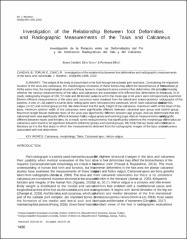| dc.contributor.author | Candan, Büşra | |
| dc.contributor.author | Torun, Ebru | |
| dc.contributor.author | Dikici, Rumeysa | |
| dc.date.accessioned | 2023-07-31T13:11:43Z | |
| dc.date.available | 2023-07-31T13:11:43Z | |
| dc.date.issued | 2022 | en_US |
| dc.identifier.uri | https://www.scopus.com/record/display.uri?eid=2-s2.0-85147370816&origin=resultslist&sort=plf-f&src=s&nlo=&nlr=&nls=&sid=20c4fe371b9b908d4f7e419f791331ff&sot=aff&sdt=cl&cluster=scofreetoread%2c%22all%22%2ct&sl=72&s=AF-ID%28%22Alanya+Alaaddin+Keykubat+University%22+60198720%29+AND+SUBJAREA%28MEDI%29&relpos=33&citeCnt=0&searchTerm= | |
| dc.identifier.uri | https://hdl.handle.net/20.500.12868/2346 | |
| dc.identifier.uri | https://www.scielo.cl/scielo.php?script=sci_arttext&pid=S0717-95022022000601490&lng=en&nrm=iso&tlng=en | |
| dc.description.abstract | The weight of the body is transmitted to the foot through the subtalar joint and talus. Considering the important location of the talus and calcaneus, the morphological structures of these bones may affect the biomechanics of the subtalar joint. At the same time, the morphological structure of these bones is important in some common foot deformities. We aimed to investigate whether the various measurements of the talus and calcaneus are associated with different foot deformities in this study. In this study, radiography images of 158 (72 male and 86 female) patients within the mean age of 44 years were retrospectively examined. Eleven different measurements of the talus and calcaneus were obtained from the lateral and antero-posterior radiographs of the patients. A total of 158 patient's routine clinic radiographs were retrospectively assessed, which have calcaneal spur (n=63), hallux valgus (n=32) and control group (n=63). We determined that the body height of the calcaneus, maximum width of the head of the talus, minimum anterior width of the calcaneus were significantly different between calcaneal spur group and control group. Maximum length fibular malleolar facet of the talus was significantly different between age groups. And we determined that the calcaneal index was significantly different between hallux valgus group and control groups. Also all measurements were significantly different between males and females. As a result, some measurements that significantly determine the morphology of the talus and calcaneus were found to be significant between deformity groups and control groups. We think that our study will contribute to the literature as it is the first study in which the measurements obtained from the radiographic images of the talus and calcaneus are associated with foot deformities. | en_US |
| dc.language.iso | eng | en_US |
| dc.relation.isversionof | 10.4067/S0717-95022022000601490 | en_US |
| dc.rights | info:eu-repo/semantics/openAccess | en_US |
| dc.subject | Calcaneal spur | en_US |
| dc.subject | Calcaneus | en_US |
| dc.subject | Morphology | en_US |
| dc.subject | Hallux valgus | en_US |
| dc.subject | Talus | en_US |
| dc.title | Investigation of the Relationship Between foot Deformities and Radiographic Measurements of the Talus and Calcaneus | en_US |
| dc.type | article | en_US |
| dc.contributor.department | ALKÜ, Fakülteler, Tıp Fakültesi, Temel Tıp Bilimleri Bölümü | en_US |
| dc.identifier.volume | 40 | en_US |
| dc.identifier.issue | 6 | en_US |
| dc.identifier.startpage | 1490 | en_US |
| dc.identifier.endpage | 1496 | en_US |
| dc.relation.journal | International Journal of Morphology | en_US |
| dc.relation.publicationcategory | Makale - Uluslararası Hakemli Dergi - Kurum Öğretim Elemanı | en_US |


















